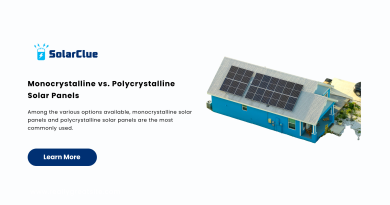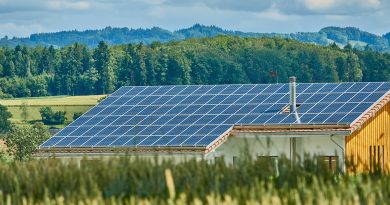How Many Solar Panels Per Acre?
When planning a solar power system, one of the most critical steps is determining the optimal number of solar panels for a given land area. Several factors influence this calculation, including the panel wattage, efficiency, land orientation, and potential shading. This blog will walk you through the process, providing calculations, examples, and practical tips for optimizing your solar installation.
Table of Contents
- 1 Understanding Solar Panel Dimensions and Wattage
- 2 Calculating the Area Required for a Specific System Size
- 3 The Impact of Roof Orientation and Tilt on Space Needs
- 4 Optimizing Solar Panel Placement for Maximum Efficiency
- 5 Considering Shading and Spacing Requirements
- 6 Alternative Installation Options
- 7 The Role of System Design in Minimizing Space Requirements
- 8 Balancing Energy Production and Available Land Area
- 9 Tools and Software for Calculating Solar Panel Area Needs
- 10 Estimated Number of Solar Panels for Different Land Areas
- 11 Conclusion
- 12 FAQ Section
Understanding Solar Panel Dimensions and Wattage
1. Solar Panel Dimensions
- Typical Sizes: Standard solar panels for residential and commercial use typically measure about 1.7 meters by 1 meter (5.5 feet by 3.25 feet), covering roughly 1.7 square meters (18 square feet) per panel.
- Variations: Panel sizes can vary slightly depending on the manufacturer and technology (e.g., monocrystalline, polycrystalline, thin-film).
2. Wattage and Efficiency
- Panel Wattage: Solar panels commonly range from 250 to 400 watts per panel. Higher wattage panels generate more electricity but may also take up more space.
- Efficiency: Solar panel efficiency determines how much sunlight the panel can convert into electricity. Higher efficiency panels require less space to produce the same amount of energy as lower efficiency panels.
Calculating the Area Required for a Specific System Size
1. System Size Calculation
- Determine Energy Needs: Start by determining your energy needs in kilowatt-hours (kWh). For example, if your home or business consumes 10,000 kWh annually, you would need a system that can generate at least this much energy.
- System Size in kW: To calculate the system size in kilowatts (kW), divide the total energy needs by the average annual solar production (in kWh/kW) in your area. For example, if your location receives 1,500 kWh/kW of solar energy per year, you would need a 6.67 kW system (10,000 kWh ÷ 1,500 kWh/kW).
2. Area Required for Panels
- Calculate Panel Area: To determine the area required for a solar system, use the following formula:
- Total Area = System Size (kW)×1,000Panel Wattage (W)×Panel Area (m²)
- Example: For a 6.67 kW system with 300-watt panels (1.7 m² each), the calculation would be:
- Total Area=6.67×1,000300×1.7=37.79 m².
The Impact of Roof Orientation and Tilt on Space Needs
1. Orientation
- South-Facing Panels: In the Northern Hemisphere, panels facing south receive the most sunlight, optimizing energy production.
- East-West Orientation: Panels facing east or west produce less energy and may require more panels (and thus more space) to generate the same amount of electricity.
2. Tilt Angle
- Optimal Tilt: The optimal tilt angle for solar panels is typically equal to the latitude of the installation site. Proper tilt ensures maximum exposure to sunlight, reducing the space needed for additional panels.
- Flat Roofs: On flat roofs, panels can be tilted using mounting systems, but this may require additional spacing to avoid shading between rows.
Optimizing Solar Panel Placement for Maximum Efficiency
1. Row Spacing
- Avoiding Shading: Proper spacing between rows of solar panels is essential to prevent shading, which can significantly reduce efficiency. This is especially important in ground-mounted systems.
- Spacing Calculation: A general rule is to space rows of panels 1.5 to 2 times the height of the panel above the ground.
2. Maximizing Land Use
- Dense Arrangements: In areas with limited land, consider denser arrangements, such as stacking panels vertically or using bi-facial panels that capture sunlight from both sides.
- Tracking Systems: Solar trackers that follow the sun’s movement can increase energy production but may require more space and higher installation costs.
Considering Shading and Spacing Requirements
1. Shading Analysis
- Conduct a Site Survey: Identify any potential shading sources (trees, buildings, etc.) that could affect panel performance. Use tools like solar pathfinders or software to analyze shading patterns.
- Designing Around Shading: Place panels in areas with the least shading, and consider microinverters or power optimizers to mitigate shading effects.
2. Space for Additional Components
- Inverters and Batteries: Allocate space for inverters, battery storage (if applicable), and other electrical components. These components can be mounted on walls or placed in utility rooms.
- Racking Systems: Ground-mounted systems require space for racking and support structures, which should be considered in the overall land area calculation.
Alternative Installation Options
1. Ground Mounts
- Benefits: Ground-mounted systems are ideal for properties with ample land. They allow for optimal orientation and tilt, and can be easier to maintain.
- Considerations: Ensure there is sufficient space for row spacing and consider the impact of any future landscaping or development.
2. Carports
- Dual Use: Carports provide shade for vehicles while generating solar power. This is a good option for commercial properties or residential areas with limited roof space.
- Structural Requirements: Carports must be designed to support the weight of solar panels and withstand environmental factors like wind and snow.
3. Rooftop Installations
- Maximizing Roof Space: Utilize as much of the available roof space as possible, taking into account any obstructions (chimneys, vents) and roof access requirements.
- Weight Considerations: Ensure the roof structure can support the additional weight of the solar panels and mounting hardware.
The Role of System Design in Minimizing Space Requirements
1. High-Efficiency Panels
- Less Space Required: High-efficiency panels generate more power per square meter, reducing the overall space needed for the system. This is particularly important for smaller properties or rooftops.
- Cost vs. Space: While high-efficiency panels may cost more upfront, they can save space and potentially reduce installation costs.
2. Optimized Layout
- Custom Design: A well-designed system layout can minimize space usage by optimizing panel orientation, tilt, and spacing. Professional solar designers can create custom layouts based on your specific site conditions.
3. Integrated Systems
- Multi-Use Designs: Consider integrating solar panels into other structures, such as pergolas, awnings, or façades, to maximize land use without dedicating additional space solely to solar panels.
Balancing Energy Production and Available Land Area
1. Energy Needs vs. Space
- System Scaling: If space is limited, you may need to scale the system to match available land while meeting as much of your energy needs as possible. Consider the trade-offs between energy independence and space constraints.
2. Future Expansion
- Planning for Growth: Design your system with the possibility of future expansion in mind. Leave space for additional panels if you anticipate increased energy needs or plan to install battery storage later.
Tools and Software for Calculating Solar Panel Area Needs
Online Calculators
- Usage: Many solar providers offer online calculators that can estimate the number of panels needed based on your location, energy needs, and available space.
- Limitations: While useful for initial estimates, online calculators may not account for all site-specific factors. A professional site assessment is recommended for final design.
Estimated Number of Solar Panels for Different Land Areas
| Land Area (Acres) | Approximate Usable Area (sq. meters) | System Size (kW) | Number of Panels (300W each) | Annual Energy Output (kWh) |
|---|---|---|---|---|
| 0.1 acres (400 m²) | 200 m² | 35 kW | 117 panels | 52,500 kWh |
| 0.25 acres (1,000 m²) | 800 m² | 140 kW | 467 panels | 210,000 kWh |
| 0.5 acres (2,000 m²) | 1600 m² | 280 kW | 933 panels | 420,000 kWh |
| 1 acre (4,000 m²) | 3200 m² | 560 kW | 1,867 panels | 840,000 kWh |
(Note: The above table assumes optimal conditions with no shading and panels arranged in a dense grid layout. Actual usable area and output may vary based on site-specific factors.)
Conclusion
Determining the optimal number of solar panels for a given land area involves careful consideration of various factors, including panel efficiency, land orientation, shading, and energy needs. By understanding these factors and using the appropriate tools and calculations, you can design a solar power system that maximizes energy production while making efficient use of available space. Whether you’re planning a small residential installation or a large commercial project, this blog provides the foundation to help you make informed decisions and achieve your solar energy goals.
Here at SolarClue®, we offer a smart, practical, and “beautiful” solution. You will be answered for all the questions related to Solar.
We provide all kinds of brands that are the Best Solar panels in India.
If you are the one who is planning for the solar power system. Don’t hesitate to contact our team!
Looking forward to empowering you with solar energy, just like hundreds of our other clients!
FAQ Section
1. How do I calculate the number of solar panels I need for a specific land area?
To calculate the number of panels, determine your desired system size (in kW), the wattage of the panels, and the available land area.
Use the formula: Number of Panels=System Size (kW)×1,000Panel Wattage (W)
2. What factors affect the space required for a solar panel installation?
Key factors include the wattage and efficiency of the panels, land orientation, tilt angle, shading, and the spacing required between rows of panels.
3. Can solar panels be installed on uneven or sloped land?
Yes, solar panels can be installed on uneven or sloped land using ground-mounted systems with adjustable racking. The tilt can be optimized for maximum sunlight exposure.
4. What is the typical space requirement for a 1 kW solar system?
A 1 kW solar system typically requires about 6.8 to 9.3 square meters (73 to 100 square feet) of space, depending on panel efficiency and layout.
5. Is it possible to expand my solar panel system in the future?
Yes, many solar systems are designed with future expansion in mind. Ensure that you leave enough space and consider the potential need for additional inverters or battery storage.



